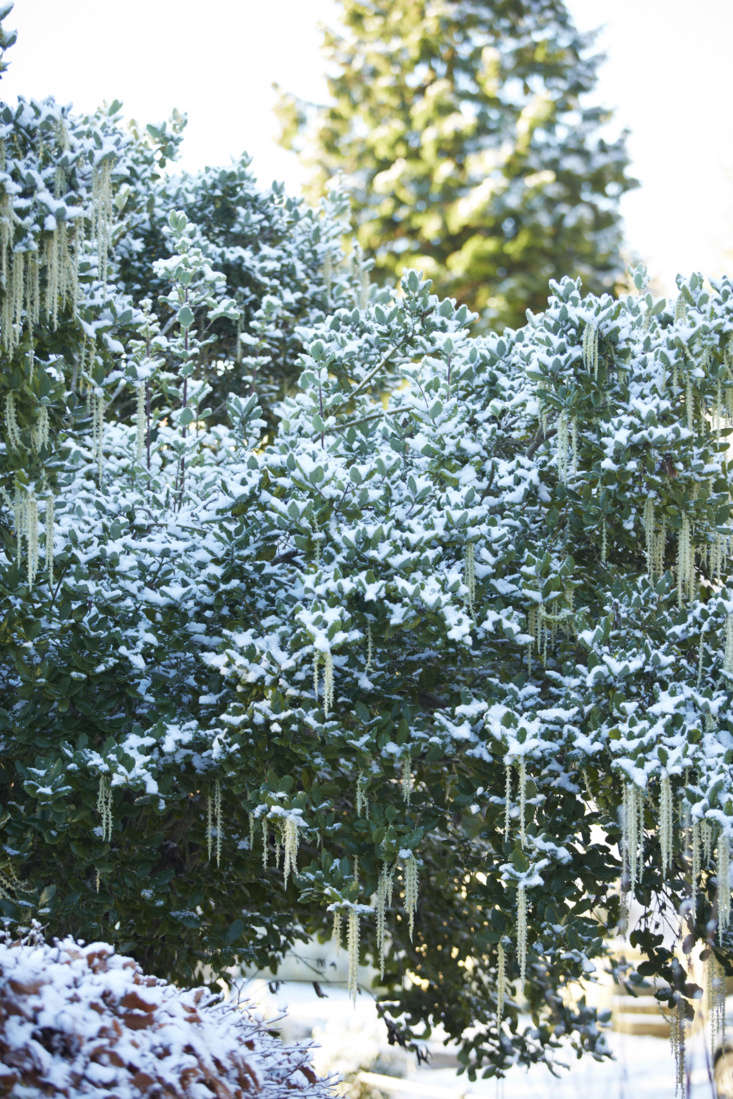Silk Tassel Bush, Garrya elliptica: “Edwardian Drapes”
When Vita Sackville-West pondered over winter plants for north-facing walls, she listed Morello cherry and winter-flowering jasmine—neither surprising in an English garden of a certain vintage. Also, silk tassel bush, another once-typical choice that is now overlooked. Sheltered, with space to spread, Garrya elliptica is terribly elegant, in an Edwardian kind of way. It is in fact an American West Coast native; it’s sea salt-tolerant and very hardy. In colder places, like rural England, it has an affinity with frost, its silver-tinged leaves drawing attention to exceptionally long catkins.
Photography by Britt Willoughby Dyer, for Gardenista.

Members of the Garryaceae family are named after a secretary of the Hudson’s Bay Company, Nicholas Garry, who helped to organize the North American expeditions for British plant hunters in the 19th century. “Elliptica” refers to the wavy-edged, evergreen leaves. Garrya has male and female plants, with tassels or catkins that are wind-pollinated. For the most spectacular tassels, it’s important to choose a male over a female. More specifically, Garrya elliptica ‘James Roof’ carries an Royal Horticultural Society award of garden merit and its catkins are from 8 to 14 inches long.

Garrya elliptica is the kind of thing you’d expect to see draping the doorway into a walled garden, facing north (or east), while plants on the other side bask in the sun. This is where I first saw one, at Kelmarsh Hall in Northamptonshire, and the setting was perfect; dripping catkins perfectly complementing the early 20th-century gardens, surrounding an early 18th-century house.

Silk tassel bush lends itself to shaping; kept flat against a wall, or hard pruned into a fan shape or espalier. It can also be cut into a hedge, or left as a free-standing shrub. But the most arcane treatment that we have ever seen is on the walls of Magdalen College, Oxford. See: The Secret History: A Master Class in Gothic Pruning (but don’t expect any catkins).

Cheat Sheet
- Garrya elliptica gives a formal assurance to a shady wall or corner. Evergreen and dioecious (with male or female plants),
- Garrya elliptica is wind-pollinated but looks better in a fairly sheltered spot.
- Garryaceae is a small family. Choose the hardiest, Garrya elliptica, (to USDA zones 8 to 10) and the most dramatically tasseled: ‘James Roof’.

Keep It Alive
- • Garrya can look sub-optimal when new evergreen leaves push through after flowering. Pruning at this stage will tidy it up but crucially, early attention allows time for new flowering buds to develop.
• Leaves are sometimes scorched after a drastic change in weather. Again, this can be dealt with in spring with a good prune.
• Garrya is not fussy about soil, or sun, but it depends on good drainage. Water-logging or conversely, summer drought can adversely affect the appearance of the plant.

See more growing tips in Silk Tassel Bush: A Field Guide to Planting, Care & Design in our curated guides to Shrubs 101. See more shrubs that look their best in winter:
- Landscape Ideas: Boxed in by Boxwood? 5 Shrubs to Try Instead
- Mahonia: A Field Guide to Planting, Care & Design
- Landscape Ideas: Blazing Color with Red Twig Dogwood, 5 Ways
- 8 Cold-Climate Flowering Shrubs and Small Trees for Early Spring
- Paperbush: A Field Guide to Planting, Care & Design










Have a Question or Comment About This Post?
Join the conversation (2)